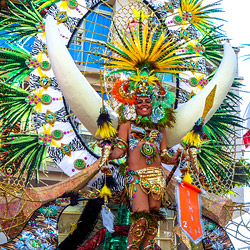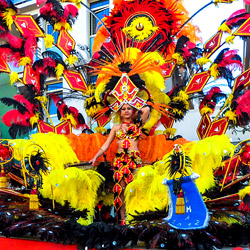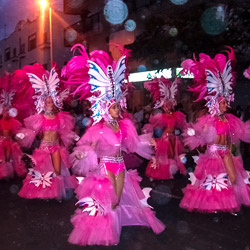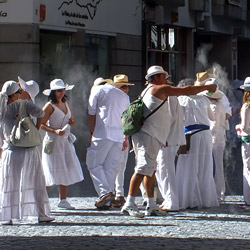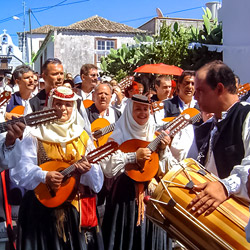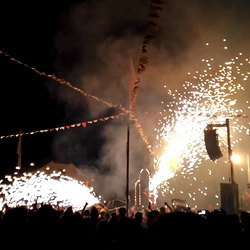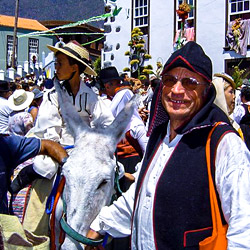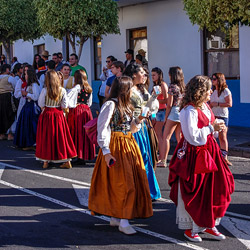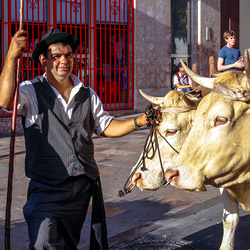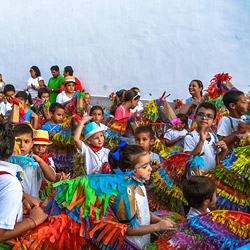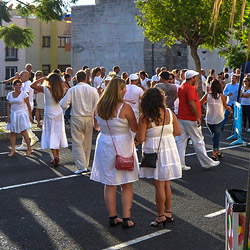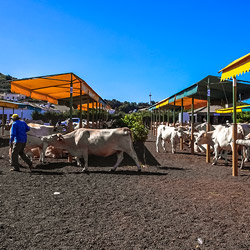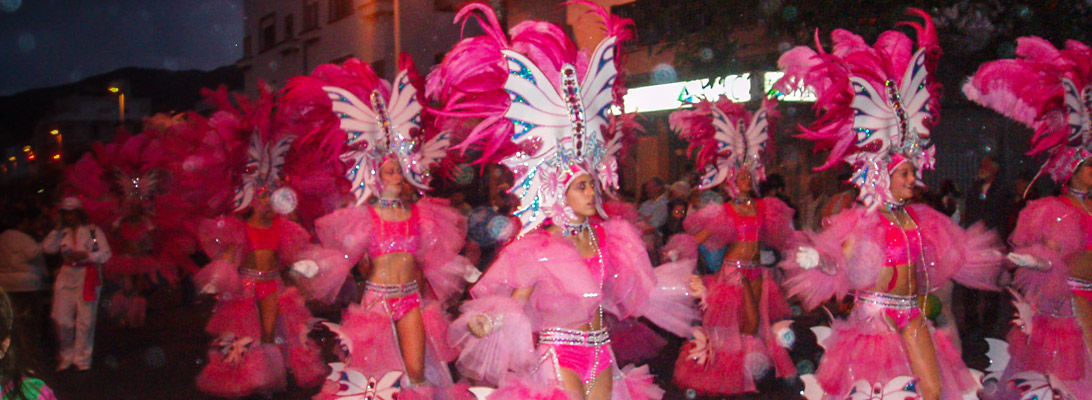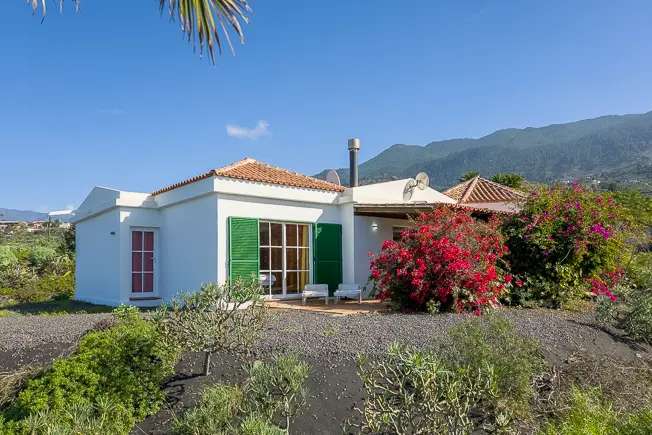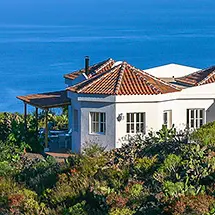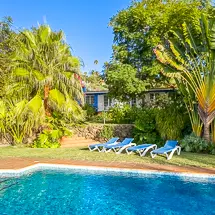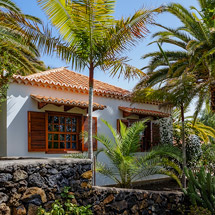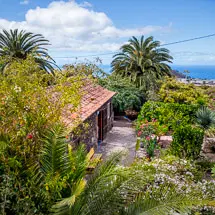What all the festivals on La Palma have in common is that they are prepared with great effort, which means days of work, but also a good atmosphere and sense of community in the neighborhoods. At the beginning of the church's annual cycle are the Three Kings (los reyes) on 6 January, at which mystery plays and processions take place on the eve of the event and the little ones receive their Christmas presents. Depending on when the almond trees bloom, the almond blossom festival, which is particularly important in Puntagorda, follows at the end of January to February.
Carnival on La Palma
Carnival in the Canary Islands is celebrated in a similarly colorful way as in South America.
Carnival centers on La Palma are capital Santa Cruz and the "secret capital" Los Llanos. Highlights in Los Llanos are the election of the Carnival Queen and the parade on Carnival Tuesday. Los Indianos" arrive in Santa Cruz on Rose Monday as rich Cuban returnees dressed in white palmeros, and also dust passers-by with white talcum or baby powder. Even if on Ash Wednesday the "sardine" (a paper-mâché figure) is buried under great lamentation, the carnival continues at many places for at least another week.
Groups perform on large open-air stages, salsa is danced on the streets till dawn. Children in costumes are dressed up and are there until late in the evening. Men dress up as women, groups adhere to a certain motto, walk through the streets together and throw cheeky remarks at each other
Los Indianos
Unique in Santa Cruz on Rose Monday is the procession "Los Indianos": Dressed in shining white, those who have come overseas (Cuba, Venezuela, thus "India") to wealth deflate in a parade through the inner city. Also, many passers-by are dressed in white, because here one is sprinkled with talcum powder or baby powder - until actually everything is white. With this custom, to which many visitors from the other Canary Islands and from abroad travel, one makes fun of the craving for the status of former wealthy Palmeros, who flaunted their wealth in white tropical suits and blossom-white dresses.
Burial of the Sardine
The "Funeral of the Sardine" on Ash Wednesday is very moving. At midnight a black dressed funeral procession starts from the Plaza de la Alameda. There are obituaries everywhere. The sardine from papier mache is finally burned directly at the sea. - and the dance on the streets continues. In Los Sauces the sardine is buried one week later anyway, so there is no trace of ashes.
Election of the Carnival Queen
Carnival highlight in Los Llanos is the carnival procession and the election of the Carnival Queen on Carnival Tuesday. The elaborate costumes with sequins and partly whole landscapes are prepared throughout the year and can only be worn, at least by the candidates for the choice of the best costume, with the support of a float. Central European visitors may think of the carnival of Rio in the splendor of these salsa or samba dancing queens in their huge costume constructions. During foolish times, many dance events take place in Los Llanos around the stage in the Plaza de España.
Local Saints and Festival of the Cross in la Palma
The Semana Santa continues in the ecclesiastical annual cycle, especially with the solemn Good Friday processions, during which valuable figures are carried through the streets. The summer is filled with various holy celebrations, most of which include a procession in honor of the local saints, a parade in traditional costumes, music, dancing and plenty of meat and wine for your physical well-being. Corpus Christi is celebrated especially in Villa de Mazo. On the third of May, the Feast of the Cross is celebrated with richly decorated crosses in many public places.
Devil's Festival, Horse Polka, Moros y Cristianos
Other important festivals are the Romería in San Antonio del Monte near Garafía, (Caballos Fufos) in the horse polka Caballos Fuscos in Fuencaliente (August) and the cheeky tissue paper horses Tazacorte (September).
At the Fiesta del Diablo in Tijarafe, a man slips into a devil's costume and frightens passers-by by igniting fireworks. In Barlovento in August (every three years, the next time in 2019) the naval battle of Lepanto (1571) against the Ottomans is reenacted with moros y cristianos. Here, cristianos disguised in front of elaborate paper-mâché backdrops are allowed to take down or capture the wonderfully orientally styled moros
Christmas on La Palma
Especially in Santa Cruz, on the nine evenings before Christmas Eve, music groups from various parishes (Los Divinos) sing Christmas carols in the night masses and then walk through the streets singing. On Christmas Eve the midnight Mass is attended, the 25th but not the 26th of December is a holiday (navidad). Worth seeing are in particular the cribs and nativity play in many places.
Bajada in Santa Cruz, the Festival of Festivals
Finally every five years (the next time in 2020), the Bajada de la Virgen de las Nieves, the festival cycle, one of the most splendid Canarian festivals of all, crowns the Bajada de la Virgen de las Nieves, which lasts one month (from the end of June to the beginning of August).
The magnificent festival in La Palma's capital Santa Cruz takes place every five years and lasts from the end of June to August. TThe reason for this tradition was a drought in 1676, during which the statue of the Virgin of the Snow (Virgen de las Nieves) was carried down from its ancestral place three kilometers above Santa Cruz in a solemn procession with priests, bishops and dignitaries in Sunday suits to the church of San Salvador in the capital. When the Virgin actually seemed to have caused rain, the then Church Prelate of Santa Cruz decided to repeat this ceremony every five years starting in 1680. According to many pious Palmeros, the Virgin also held her protective hand over La Palma during volcanic eruptions, storms and pirate raids. New festive customs were added to the Bajada so that the capital is in a state of turmoil for weeks.
Semana Chica
It begins on the last Sunday in June with the bearing down of the silver throne of the Madonna in 42 parts. This date marks the beginning of the so-called "Semana Chica" (Short Week) with a procession of chariots, religious events and a children's lantern procession.
Semana Grande
The Semana Grande begins on the second Sunday of July. Now the mascarones, paper-mâché figures with giant heads, are presented, representing local politicians and personalities, fairy tale or comic figures. On Wednesday of the "big week", minuets in 18th-century costumes will be performed, for which no expense will be spared, and on Thursday the famous dwarf dance ("Danza de los Enanos"), the highlight of the Bajada, will be performed.
Danza de los Enanos
The special feature here is that actors, under oversized head and hat masks and in tiny leg dresses, convey the illusion that they are dwarves. Unforgettable is the sight of these numbered dwarves with their legs tied together above their knees, dancing the whole night through like puppets hopping polka! The dance ends at the Plaza de la Alameda. As a reminder, the square is decorated with a dwarf statue. This custom was also added to the Bajada later. After an acrobatics show and a large arts and crafts exhibition at the harbor, themes from the life of the Blessed Virgin are finally presented on Friday in a "triumphal chariot".
Ending of the Bajada
On Saturday the time has come: The statue of Mary, dressed in new and precious garments, is carried into the city by twelve men in a sedan chair after a solemn mass. In the night from Saturday to Sunday she (together with the pilgrims) stops at the church "La Encarnación" on the outskirts of the city. On Sunday the procession continues. Before reaching the center of Santa Cruz, in the "Barranco de las Nieves", the ritual dialogue takes place between the city fort and the ship "Santa Maria" (the replica of the Columbus flagship) about the entry of the saints into the city - carried out by megaphone in rhyme. The last stage leads to the church of El Salvador in the Plaza de España, where the statue of the Virgin remains until the beginning of August. The final ceremony is celebrated with a crackling fireworks display.
Cultural program for the Bajada in Santa Cruz
During the Bajada there are numerous concerts, costume performances, theatres, competitions, and processions. The whole city is then over the moon, also because so many Palmeros come from abroad to celebrate this time in their homeland. Celebrations usually take place on the streets until the early hours of the morning. Everyone dances or is actively involved in the events. Those who fear loud music and crowds should at least avoid the capital of La Palma during this time.







